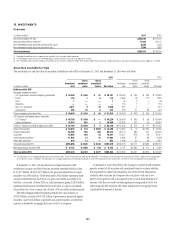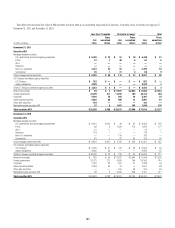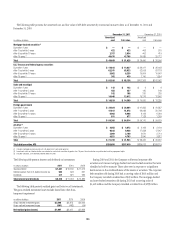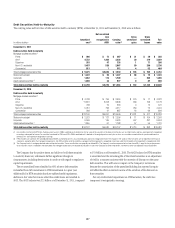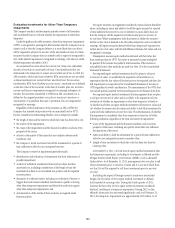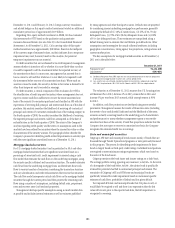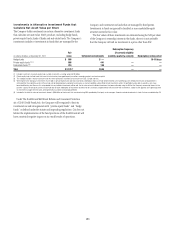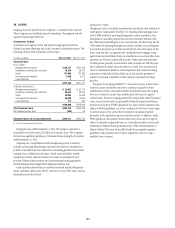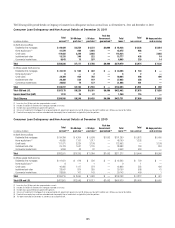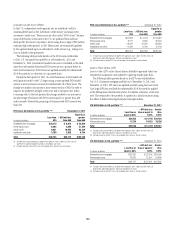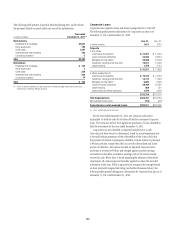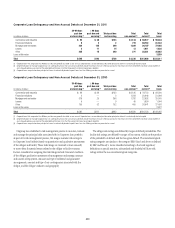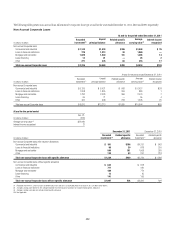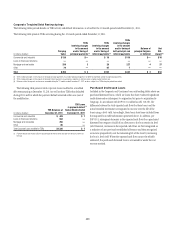Citibank 2011 Annual Report Download - page 216
Download and view the complete annual report
Please find page 216 of the 2011 Citibank annual report below. You can navigate through the pages in the report by either clicking on the pages listed below, or by using the keyword search tool below to find specific information within the annual report.
194
16. LOANS
Citigroup loans are reported in two categories—Consumer and Corporate.
These categories are classified primarily according to the segment and sub-
segment that manages the loans.
Consumer Loans
Consumer loans represent loans and leases managed primarily by the
Global Consumer Banking and Local Consumer Lending businesses. The
following table provides information by loan type:
In millions of dollars Dec. 31, 2011 æ$ECææ
Consumer loans
)Næ53æOFFICES
-ORTGAGEæANDæREALæESTATEæ $139,177
)NSTALLMENTæREVOLVINGæCREDITæANDæOTHER 15,616
#ARDS 117,908
#OMMERCIALæANDæINDUSTRIAL 4,766
,EASEæFINANCING 1
$277,468
)NæOFFICESæOUTSIDEæTHEæ53
-ORTGAGEæANDæREALæESTATEæ $ 52,052 æ
)NSTALLMENTæREVOLVINGæCREDITæANDæOTHER 34,613
#ARDS 38,926
#OMMERCIALæANDæINDUSTRIAL 20,366
,EASEæFINANCING 711
$146,668
Total Consumer loans $424,136
.ETæUNEARNEDæINCOMEæLOSS (405)
Consumer loans, net of unearned income $423,731
æ ,OANSæSECUREDæPRIMARILYæBYæREALæESTATE
During the year ended December 31, 2011, the Company sold and/or
reclassified (to held-for-sale) $21 billion of Consumer loans. The Company
did not have significant purchases of Consumer loans during the 12 months
ended December 31, 2011.
Citigroup has a comprehensive risk management process to monitor,
evaluate and manage the principal risks associated with its Consumer loan
portfolio. Included in the loan table above are lending products whose terms
may give rise to additional credit issues. Credit cards with below-market
introductory interest rates and interest-only loans are examples of such
products. However, these products are closely managed using appropriate
credit techniques that mitigate their additional inherent risk.
Credit quality indicators that are actively monitored include delinquency
status, consumer credit scores (FICO), and loan to value (LTV) ratios, each as
discussed in more detail below.
Delinquency Status
Delinquency status is carefully monitored and considered a key indicator of
credit quality. Substantially all of the U.S. residential first mortgage loans
use the MBA method of reporting delinquencies, which considers a loan
delinquent if a monthly payment has not been received by the end of the
day immediately preceding the loan’s next due date. All other loans use the
OTS method of reporting delinquencies, which considers a loan delinquent
if a monthly payment has not been received by the close of business on the
loan’s next due date. As a general rule, residential first mortgages, home
equity loans and installment loans are classified as non-accrual when loan
payments are 90 days contractually past due. Credit cards and unsecured
revolving loans generally accrue interest until payments are 180 days past
due. Commercial market loans are placed on a cash (non-accrual) basis
when it is determined, based on actual experience and a forward-looking
assessment of the collectability of the loan in full, that the payment of
interest or principal is doubtful or when interest or principal is 90 days
past due.
The policy for re-aging modified U.S. Consumer loans to current status
varies by product. Generally, one of the conditions to qualify for these
modifications is that a minimum number of payments (typically ranging
from one to three) be made. Upon modification, the loan is re-aged to
current status. However, re-aging practices for certain open-ended Consumer
loans, such as credit cards, are governed by Federal Financial Institutions
Examination Council (FFIEC) guidelines. For open-ended Consumer loans
subject to FFIEC guidelines, one of the conditions for the loan to be re-aged
to current status is that at least three consecutive minimum monthly
payments, or the equivalent amount, must be received. In addition, under
FFIEC guidelines, the number of times that such a loan can be re-aged is
subject to limitations (generally once in 12 months and twice in five years).
Furthermore, Federal Housing Administration (FHA) and Department of
Veterans Affairs (VA) loans are modified under those respective agencies’
guidelines, and payments are not always required in order to re-age a
modified loan to current.


